Montages in Film Explained: Here Are Its 5 Main Functions
Rent film gear from local filmmakers.

Rent film gear from local filmmakers.
When you are in the process of making a film, you probably already know that there's more to it than just writing a script and filming.
Maybe you remember going to school and your teacher asking the question:" Who can give a summary of what the movie is about?"
You would probably respond by highlighting the main events in the film.
What genre it was and what the message in the movie was. What did you learn by watching that specific movie?
– That's the effect a montage can give you.
If you keep on reading, this article will help you understand what a montage is, its effects on the audience, which film techniques are used, and what five functions a montage should include.
If you want to know more about filmmaking - fear not! We have made an article on filmmaking 101, telling you about all of the basic things you need to know.
What is a montage?
The word montage is French for "assembly" or "editing." It's a technique used to help the director and the movie editor advance the story effectively and quickly. The technique combines a series of short shots or clips into one sequence.
For example, a person in the movie could train for an important event. We see the person doing a series of demanding exercises in a flash. Fourteen days of training are displayed in 30 seconds. Cutting the scenes shortens the time.
A montage is often shown with music in the background because it creates emotions in your audience.
Film techniques used in montages
- Music
- Quick cuts
- Voice-over narration
- Minimal or no dialogue
- Repeated camera movements

5 functions of montages
As promised, here are five important functions you should include when making a montage.
1. Speeding up time
So, one of the main functions of a montage is accelerating time. It doesn't matter if it's a day, a month, or a decade.
Today the average film runs between 90 and 120 minutes, and you can't show a month or decade in a movie without accelerating time unless you want your audience to get bored and lose interest in the film.
When you accelerate time, you start by cutting in scenes that are already taken, placing the clips together, and as a result of this showing your audience the result of something that seems like it took forever to do, but you show it in 30 sec to 1 minute. When you accelerate the time, it helps your audience understand more about the movie and stay true to the story.
2. Developing characters
A montage can also be used to develop characters in a movie.
You know the scene in a film where the main character is training for a big event?
He starts with a fierce struggle, but with motivation and resilience, he becomes the best version of himself.
For instance, take the movie Rocky (1976). Rocky was challenged by the steps of the Philadelphia Art Museum but kept on training, and then he succeeded. Now the steps have become extremely popular and are known as "the rocky steps."
In this way, a montage can create the most memorable scenes in a movie because of their unique ability to communicate a lot of information in a shorter amount of time.
So how did this montage become so popular? By building a gestalt.

3. Building a gestalt
When building a gestalt, the main focus should be to teach your audience something significant within themselves or the movie's environment. In that way, they will respond with a sense of wholesomeness and reasonable to the situation in the film.
What did the montage of Rocky training teach the audience? To never give up.
If you want something badly enough, you can get it. But again, it depends on how and what you interpret the montage.
4. Combining multiple storylines
Another important function in making a montage is combining multiple storylines.
There won't always be time to feature every storyline from start to finish; sometimes, the storyline needs to be shortened. Or perhaps numerous storylines need to intertwine different narratives within the same scene.
A montage is an effective way to combine the storylines to ensure every character gets their due or intertwine other narratives in the same scene.
In this way, a montage also has the power to drive home the theme of the movie within one scene.
5. Creating meaning with juxtaposition
At last, montages create meaning with juxtaposition. The juxtaposition function is a device that implies comparison or contrast within a scene. You should start by placing two characters side by side to create a dramatic or ironic contrast.
For example, the movie The Little Things (2021), It's about two completely different detectives; they have different backgrounds and different approaches to solving the mystery of finding the murderer. But at the end of the movie (spoiler alert warning), we see that they had the same destiny coming for them, despite their differences.
Become a better scriptwriter
If you found this article interesting and want to learn more about how to become a better scriptwriter click here.
Montage FAQ
What is a montage?
A montage is a technique used to select, edit, and piece together separate sections of a film to form a continuous whole.
What is the definition of a montage?
The definition of a montage is, “the production of a rapid succession of images in a motion picture to illustrate an association of ideas.”






















